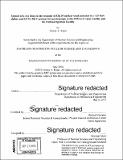Impact of x-ray dose on the response of CR-39 nuclear track detector to 1-5.5 MeV alphas and 0.5-9.1 MeV protons for spectroscopy at the OMEGA Laser Facility and the National Ignition Facility
Author(s)
Rojas, Jimmy A. (Rojas Herrera)
DownloadFull printable version (5.971Mb)
Other Contributors
Massachusetts Institute of Technology. Department of Nuclear Science and Engineering.
Advisor
Richard Petrasso.
Terms of use
Metadata
Show full item recordAbstract
The CR-39 nuclear track detector is used in many nuclear diagnostics fielded at inertial confinement fusion (ICF) facilities. Large x-ray fluences generated by ICF experiments may impact the CR-39 response to incident charged particles. To determine the impact of x-ray exposure on the CR-39 response to protons and alpha particles, a thick-target bremsstrahlung x-ray generator was used to expose CR-39 to various doses of 30 and 8keV Cu-K[alpha] and K[beta] x-rays. The CR-39 detectors were then exposed to 1-5.5 MeV alphas or 0.5- 9.1 MeV protons. The regions of the CR-39 exposed to x-rays showed a smaller track diameter than those not exposed to x-rays: for example, a dose of 3.0±0.1 Gy causes a decrease of (19±2)% in the track diameter of a 5.5 MeV alpha, while a dose of 6.0±0.1 Gy results in a decrease of (29±1)% in the track diameter of a 3.0 MeV proton. The reduced track diameters were found to be predominantly caused by a comparable reduction in the bulk etch rate of the CR-39 with x-ray dose. A residual effect, due to changes in track etch rate and dependent on incident particle energy, was characterized by an empirical formula.
Description
Thesis: S.B., Massachusetts Institute of Technology, Department of Nuclear Science and Engineering, June 2016. Page 47 blank. Cataloged from PDF version of thesis. Includes bibliographical references (pages 45-46).
Date issued
2016Department
Massachusetts Institute of Technology. Department of Nuclear Science and EngineeringPublisher
Massachusetts Institute of Technology
Keywords
Nuclear Science and Engineering.